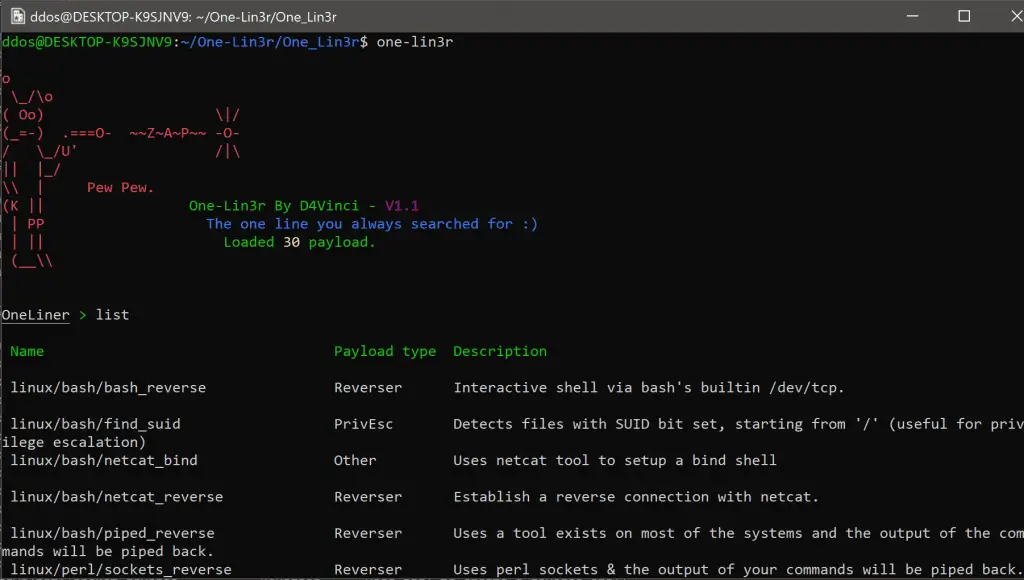One-Lin3r v2.1 releases: light-weight framework inspired by the web-delivery module in Metasploit

One-Lin3r is simple modular and light-weight framework gives you all the one-liners that you will need while penetration testing (Windows, Linux, macOS or even BSD systems) or hacking generally with a lot of new features to make all of this fully automated (ex: you won’t even need to copy the one-liners).

It consists of various one-liners types with various functions, some of them are:
| One-liner function | What this function refers to |
|---|---|
| Reverse Shell | Various methods and commands to give you a reverse shell. |
| PrivEsc | Many commands to help in Enumeration and Privilege Escalation |
| Bind Shell | Various methods and commands to give you a bind shell. |
| Dropper | Many ways to download and execute various payload types with various methods. |
Features
- A lot of liners use with different purposes, currently are more than 155 liner.
- The auto-complete feature that has been implemented in this framework is not the usual one you always see, here are some highlights:
- It’s designed to fix typos in typed commands to the most similar command with just one tab click so
seachbecomessearchand so on, even if you typed any random word similar to an command in this framework. - For you lazy-ones out there like me, it can predict what liner you are trying to use by typing any part of it. For example if you typed
use capabilitiesand clicked tab, it would be replaced withuse linux/bash/list_all_capabilitiesand so on. I can see your smile, You are welcome! - If you typed any wrong command then pressed enter, the framework will tell you what is the nearest command to what you have typed which could be the one you really wanted.
- Some less impressive things like auto-complete for variables after
setcommand, auto-complete for liners afteruseandinfocommands and finally it converts all uppercase to lowercase automatically just-in-case you switched cases by mistake while typing. - Finally, you’ll find your normal auto-completion things you were using before, like commands auto-completion and persistent history, etc…
- It’s designed to fix typos in typed commands to the most similar command with just one tab click so
- Automation
- You can automatically copy the liner you want to clipboard with command
copy <liner>instead of usinguse <liner>and then copying it which saves a lot of time, of course, if you merged it with the following features. - As you may noticed, you can use a resource file from command-line arguments before starting the framework itself or send commands directly.
- Inside the framework you can use
makerccommand like in Metasploit but this time it only saves the correct important commands. - There are
historyandresourcecommands so you don’t need to exit the framework. - You can execute as many commands as you want at the same time by splitting them with semi-colon.
- Searching for any liner here is so easy and accurate, you can search for a liner by its name, function, description, author who added the liner to the framework or even the liner itself.
- You can automatically copy the liner you want to clipboard with command
- You can add your own liners by following these steps to create a liner as a python file. After that you can make a Pull request with it then it will be added in the framework and credited with your name of course 😄.
- The ability to reload the database if you added any liner without restarting the framework.
- You can add any platform to the liners database just by making a folder in liners folder and creating a “.liner” file there.
- More…
Changelog v2.1
- Fixed the Unicode conflict in windows.
- Fixed the modules path problem in windows that was causing the ModuleNotFound error.
- Fixed check for update feature.
- Added new options to search command, now search is more accurate and deep.
- Added more information about how to install the framework more easily.
- Added 21 new liners to become the total number of liners now is 176 liner.
Installing and requirements
To make the tool work at its best you must have :
- Python 3.x or 2.x (preferred 3).
- Linux (Tested on kali rolling) or Windows system (Not tested yet on MacOS but it should work).
- The requirements mentioned in the next few lines.
Installing
+For windows : (After downloading the ZIP and unzip it)
+For Linux :
Usage
Commandline arguments
Framework commands
Demo
Copyright (C) 2018 D4Vinci1
Source: https://github.com/D4Vinci/






